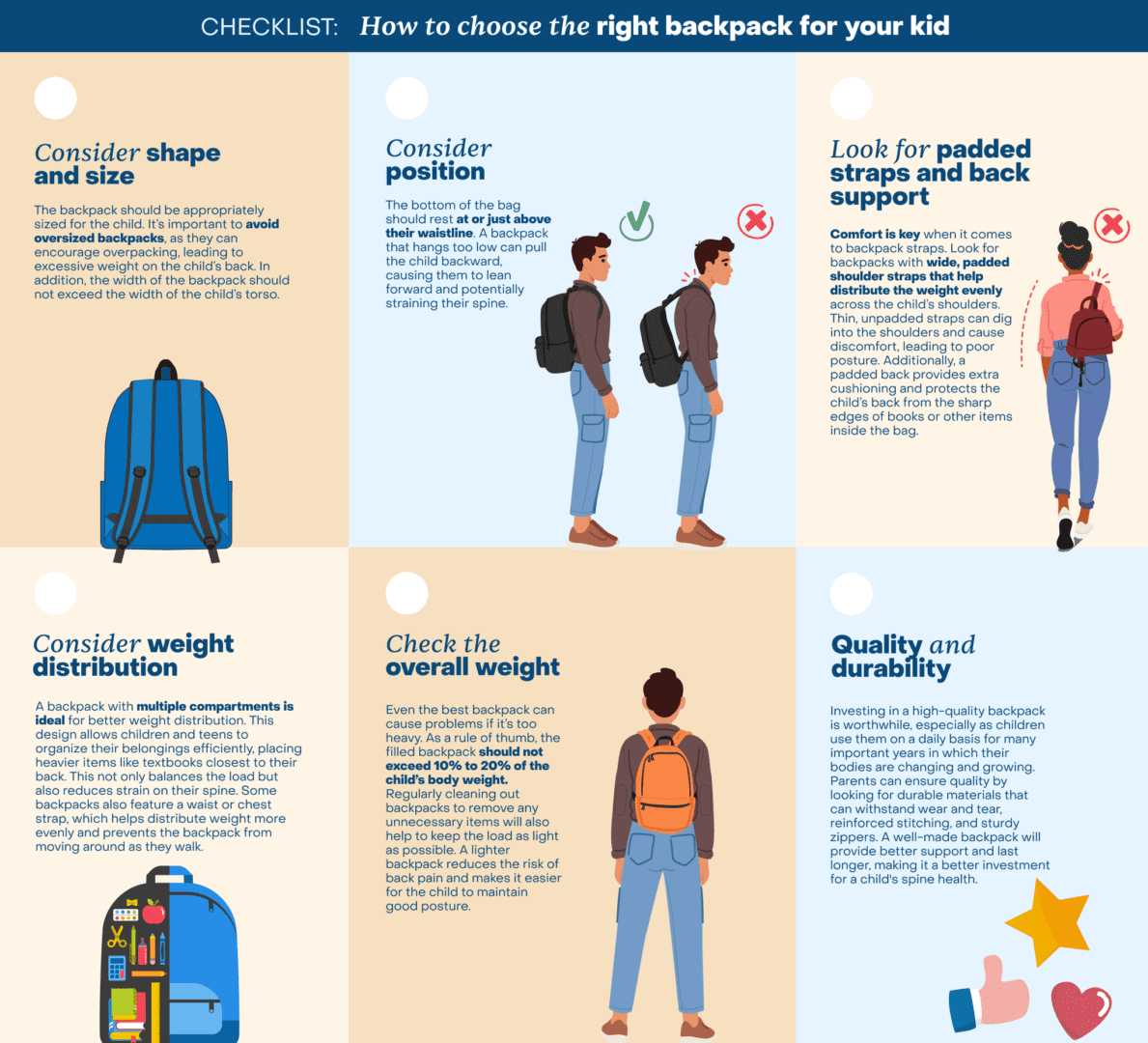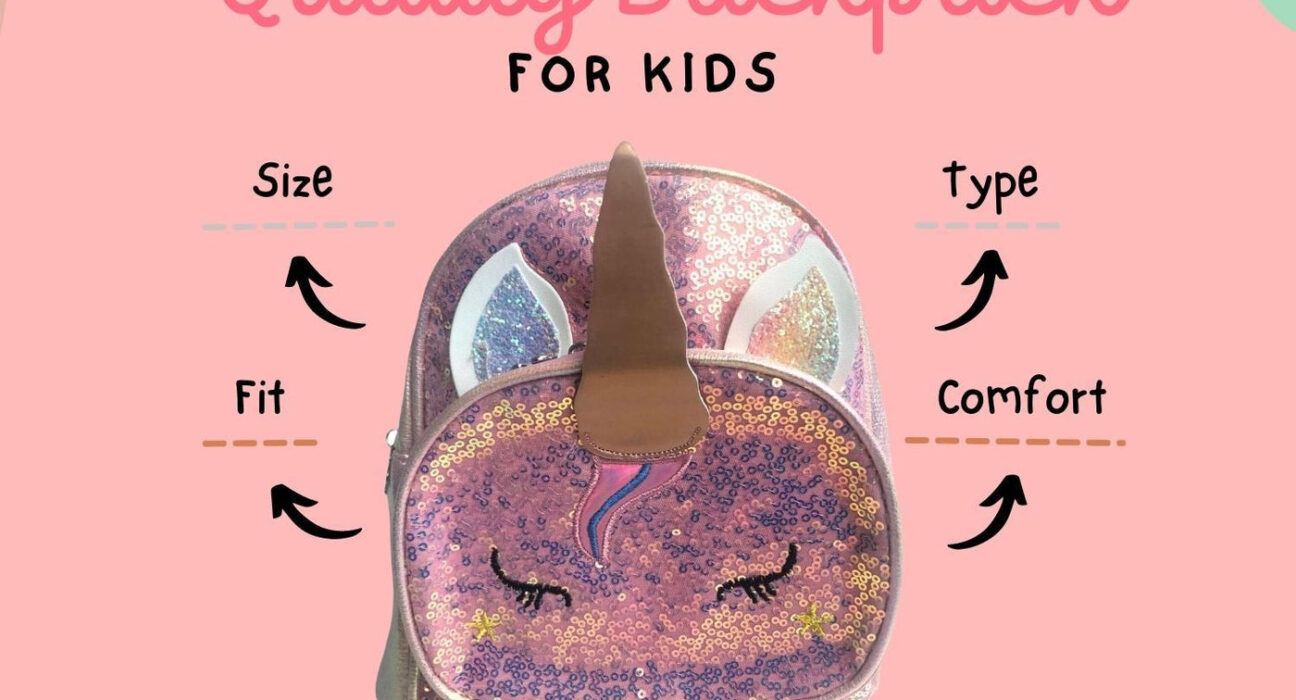Choosing the right backpack for your kids is important. A good backpack can help them carry their books, supplies, and even snacks.
With so many options available, finding the perfect one can feel overwhelming. Parents must think about several factors to make the best choice. Comfort is key. A backpack should fit well and not hurt their back. Size matters too. It should hold everything they need without being too heavy.
Durability is also essential. Kids are active, and their backpack should last through daily use. Style and design can make a difference, as kids want to feel good about what they carry. This guide will help you understand what to look for in a backpack for your child.
Table of Contents

Credit: lolaandtheboys.com
Introduction To Kids’ Backpack Essentials
Choosing the right backpack for your child is important. A good backpack helps carry their school supplies. It also affects their comfort and health. Parents should know what to look for. This guide covers key points to consider.
Why The Right Backpack Matters
The right backpack makes a big difference. It can affect how your child feels at school. Here are some reasons why it matters:
- Comfort: A well-fitted backpack reduces strain on the back.
- Organization: Multiple compartments help keep supplies organized.
- Durability: Quality materials ensure the backpack lasts longer.
- Style: A backpack that your child likes can boost their confidence.
Choosing a backpack is not just about looks. It is about supporting your child’s daily activities.
Impact Of Backpacks On Child Development
Backpacks can influence your child’s growth. Here are some impacts to consider:
| Aspect | Impact |
|---|---|
| Physical Health | Heavy backpacks can cause back pain. |
| Emotional Health | A stylish backpack can boost self-esteem. |
| Social Skills | Shared interests in styles can build friendships. |
Parents should choose wisely. A good backpack supports overall development.
Evaluating Backpack Size And Fit
Choosing the right backpack for your child is important. Size and fit play a big role. A well-fitted backpack can help prevent discomfort and injuries. It can also make carrying school supplies easier. Let’s explore how to find the perfect size and fit.
Ideal Backpack Proportions For Children
The backpack should match your child’s height and weight. Look for a backpack that is not too large or too small. The top of the backpack should sit just above the shoulders. The bottom should rest at the waist or slightly above. This position helps distribute weight evenly.
Check the width too. It should not extend beyond the child’s shoulders. A wider backpack can cause strain. A narrow one may not hold enough items. Consider the depth as well. A backpack that is too deep can be hard to manage.
Adjustment Features For Growth
Kids grow quickly. An adjustable backpack can adapt to their size. Look for straps that can be lengthened or shortened easily. These features help ensure a snug fit as they grow.
Some backpacks have padded straps. These help with comfort and support. Make sure the straps are adjustable for a better fit. A good fit reduces the risk of back pain.
Also, check for a chest strap or waist belt. These features help stabilize the load. They keep the backpack close to the body, which is safer. A well-fitted backpack is essential for your child’s health.
Material And Durability Considerations
Choosing the right backpack involves thinking about material and durability. A sturdy backpack lasts longer and protects your child’s belongings. Look for backpacks that can withstand daily use and various conditions.
Choosing Weather-resistant Fabrics
Weather-resistant fabrics are essential for kids’ backpacks. They protect against rain, snow, and spills. Look for materials like nylon or polyester. These fabrics resist moisture and dry quickly.
Check for coatings like polyurethane. This adds extra water resistance. A weather-resistant backpack keeps books and supplies safe. Kids can play outside without worrying about wet items.
Importance Of High-quality Zippers And Seams
High-quality zippers and seams are crucial for durability. Zippers should glide smoothly and close securely. Weak zippers can break easily, leaving items exposed.
Check the seams for double stitching. This adds strength and prevents fraying. Strong seams help the backpack last longer. They ensure the bag can handle heavy loads and daily wear.

Credit: spinehealth.org
Comfort Factors In Backpack Design
Choosing the right backpack for your kids goes beyond style. Comfort is key. A good backpack should support young bodies. Proper design helps prevent pain and discomfort. Focus on padding, support, and breathable materials.
Padding And Support For Young Shoulders
Kids carry heavy loads. A backpack with adequate padding is essential. Look for the following features:
- Thick Shoulder Straps: Wider straps help distribute weight.
- Adjustable Straps: Ensure a snug fit as kids grow.
- Padded Back Panel: Provides comfort against the back.
These features can reduce strain on young shoulders. Choose a backpack that offers good support. This ensures kids can carry their belongings without discomfort.
Breathable Materials For Back Comfort
Breathable materials keep kids cool and comfortable. Look for backpacks made of:
- Mesh Fabric: Allows air circulation.
- Lightweight Materials: Reduces overall weight.
- Moisture-Wicking Fabric: Keeps sweat away.
These materials help prevent overheating. Comfort is crucial, especially during long school days. A well-ventilated backpack enhances overall satisfaction.
Safety Features To Look For
Choosing a backpack for kids means prioritizing safety. Safety features help protect children in various situations. Here are key elements to consider.
Reflective Elements For Visibility
Visibility is crucial for kids, especially in low-light conditions. Reflective elements make backpacks more visible to drivers and pedestrians.
- Look for reflective strips on the front and sides.
- Choose bright colors for better visibility during the day.
- Check for 3M reflective materials for high visibility.
These features enhance safety during early mornings or late afternoons.
Secure Closures To Protect Belongings
Secure closures keep items safe inside the backpack. Zippers and clasps should be sturdy and easy to use.
- Choose zippers with a locking mechanism.
- Look for magnetic or snap closures for quick access.
- Ensure the backpack has inner pockets to organize small items.
These secure closures prevent items from falling out. They also protect valuables from theft.
| Feature | Description |
|---|---|
| Reflective Strips | Enhance visibility in low-light conditions. |
| Sturdy Zippers | Keep belongings secure and safe. |
| Inner Pockets | Help organize small items and keep them safe. |
Style And Personalization
Choosing a backpack for kids goes beyond just practicality. Style and personalization matter. Kids want to carry something that reflects their personality. A fun and stylish backpack can boost their confidence. Parents should consider both fashion and function.
Balancing Fashion With Function
Finding the right backpack means balancing style and usefulness. Here are key points to consider:
- Durability: Look for strong materials that last.
- Comfort: Padded straps are essential for comfort.
- Size: Choose a size that fits their needs.
- Design: Fun designs can make carrying books enjoyable.
Consider color and design. Bright colors attract kids. Patterns can show their interests. A stylish backpack can make them excited for school.
Allowing Kids To Express Individuality
Kids love to express who they are. Let them pick their backpack. This choice empowers them. It also boosts their creativity. Here are some ideas for personalization:
- Choose their favorite color.
- Look for backpacks with fun characters.
- Add patches or stickers.
- Consider custom embroidery with their name.
Personalizing a backpack makes it special. It becomes more than just a bag. It becomes a part of their identity.
Compartmentalization For Organization
Choosing a backpack with good compartmentalization helps keep kids organized. A well-organized backpack can make school days smoother. Kids can find their items easily. This saves time and reduces stress.
Pockets And Dividers For School Supplies
Look for backpacks with many pockets and dividers. These features help separate school supplies. Here are some important pockets to consider:
- Main Compartment: For books and binders.
- Front Pocket: For pens, pencils, and small items.
- Side Pockets: Great for water bottles.
Dividers within the main compartment can help too. They keep items from mixing. Kids can find what they need quickly. This is especially useful during busy mornings.
Special Compartments For Electronics
Many kids carry electronics to school. A backpack with special compartments is essential. These compartments protect devices like tablets and laptops. Consider these features:
- Padded Laptop Sleeve: Protects laptops from bumps.
- Tablet Pocket: Keeps tablets safe and secure.
- Headphone Slots: For easy access to headphones.
These special compartments prevent damage. They also keep cords organized. Kids can enjoy using their devices without worry.
Weight Distribution And Load Management
Choosing the right backpack for kids involves more than just style. Weight distribution and load management are crucial. A well-balanced backpack helps prevent strain on a child’s back. It also promotes good posture. This section covers strategies to ensure your child’s backpack is safe and comfortable.
Strategies To Prevent Overpacking
Kids often want to carry too much. Here are some strategies to help them pack wisely:
- Set a Weight Limit: Keep the backpack weight at 10-15% of their body weight.
- Use a Packing List: Create a list of essentials to avoid extra items.
- Check for Unused Items: Encourage kids to remove items not needed for the day.
These tips help kids pack lighter. A lighter backpack reduces the risk of injury.
Teaching Kids How To Pack Efficiently
Teach kids effective packing skills. This helps them manage their load better:
- Place Heavy Items Low: Keep heavy books at the bottom.
- Use All Compartments: Distribute weight evenly across pockets.
- Use Padded Straps: Ensure straps are comfortable and adjustable.
- Utilize External Pockets: Store smaller items in external pockets for easy access.
Proper packing techniques enhance comfort. Kids will feel better throughout the day.
Ease Of Maintenance And Cleaning
Kids can be messy. Backpacks often get dirt and stains. Choosing a backpack that is easy to clean is essential. This saves time and effort. It also keeps the backpack looking new longer.
Selecting Easy-to-clean Materials
Look for materials that resist stains. Fabrics like nylon or polyester are great choices. They repel dirt and moisture. These materials can handle daily wear and tear. Easy-to-clean backpacks often have a wipeable surface. This makes quick clean-ups simple.
Some backpacks come with removable liners. These can be washed separately. This feature is useful for maintaining hygiene. Check for water-resistant coatings, too. They help protect against spills and rain.
Simple Cleaning Routines For Kids’ Backpacks
Establish a cleaning routine for the backpack. Teach kids to empty their bags daily. This helps prevent clutter and dirt build-up. Spot cleaning can handle most stains. A damp cloth with mild soap works well.
Encourage kids to help with cleaning. This builds responsibility. For deep cleaning, follow the manufacturer’s instructions. Some backpacks can be machine washed. Make sure to air dry them afterward.
Regular maintenance keeps the backpack fresh. Check the zippers and straps for wear. Repair any damage quickly to extend the bag’s life.
Eco-friendly Options
Choosing an eco-friendly backpack is a smart choice. These backpacks help the planet. They are made from sustainable materials. Your kids can carry their books while supporting the environment.
Eco-friendly options are growing in popularity. Parents want to make responsible choices. A backpack made from recycled materials is a great start. It teaches kids the importance of sustainability.
Benefits Of Choosing Sustainable Materials
Sustainable materials are good for the Earth. They reduce waste and pollution. Using recycled materials helps decrease the need for new resources. This means less energy is used in production.
Eco-friendly backpacks often use safe dyes. These dyes are better for your child’s health. They are free from harmful chemicals. A safer choice for your family is always best.
Popular Eco-friendly Backpack Brands
Many brands offer eco-friendly backpacks. Some well-known names include Patagonia and Terra Thread. These brands focus on sustainability and quality.
Other great options are L.L. Bean and REI. They provide durable backpacks made from recycled materials. Each brand has its unique style and features.
Choosing an eco-friendly backpack supports a cleaner planet. It sets a positive example for your kids.
Practical Accessories And Enhancements
Choosing the right backpack for kids is not just about size and color. Practical accessories and enhancements can make a big difference. They add functionality and fun. Look for features that suit your child’s needs.
Useful Add-ons: Water Bottle Holders, Key Clips
Staying hydrated is important. A backpack with a water bottle holder makes it easy for kids to carry drinks. This feature keeps them refreshed during school or playtime.
Key clips are another useful add-on. They help keep keys safe and easy to find. No more digging through the backpack to find lost keys. These clips can save time and frustration.
Customizable Patches And Charms
Kids love to express themselves. Customizable patches and charms let them personalize their backpacks. They can choose designs that reflect their interests and style.
These additions make the backpack unique. It also helps kids feel proud of their belongings. Encourage creativity and self-expression with fun patches and charms.
| Accessory | Benefit |
|---|---|
| Water Bottle Holder | Keeps drinks accessible and reduces spills. |
| Key Clip | Holds keys securely and prevents loss. |
| Customizable Patches | Allows personal expression and creativity. |
| Charms | Adds fun and uniqueness to the backpack. |

Credit: www.omegapediatrics.com
Budgeting For Your Child’s Backpack
Choosing a backpack for your child involves many choices. One of the biggest decisions is the budget. You want to find a backpack that is both affordable and durable. Setting a budget helps narrow down your options. It also ensures you find a bag that lasts.
Think about how often your child will use the backpack. Daily use may require a sturdier bag. A good budget plan helps you balance cost and quality. This way, you avoid overspending on trendy options that may not last.
Finding The Balance Between Cost And Quality
Finding the right balance between cost and quality is important. Cheaper backpacks may seem like a good deal. However, they might not hold up over time. Look for materials that resist wear and tear. Check for sturdy zippers and reinforced seams.
Quality backpacks often come with warranties. This adds value to your purchase. A higher-quality bag can last several years. It can save money in the long run. Invest time in researching brands and reading reviews.
When To Invest In A Higher-priced Model
Some situations call for a higher-priced backpack. If your child is active in sports, a specialized bag may be needed. These bags often offer extra features. Look for moisture-wicking materials or padded compartments for gear.
Consider your child’s age and school requirements. Older kids may need bags that carry more books or devices. A higher-priced model can offer better support and comfort. If your child has specific needs, this investment is often worth it.
Conclusion: Making The Smart Choice
Choosing the right backpack for kids is essential. A good backpack supports learning and play. Comfort, size, and style matter. Parents and kids should work together. This makes the selection process enjoyable and effective.
Recap Of Key Considerations
Here are the main factors to remember:
- Size: Choose a size that fits your child well.
- Weight: Ensure the backpack is lightweight.
- Comfort: Look for padded straps and a supportive back.
- Durability: Select materials that withstand daily use.
- Style: Let your child express their personality.
- Safety: Reflective materials increase visibility.
Consider these points to narrow down your options. A thoughtful choice enhances your child’s daily experience.
Empowering Kids To Make Their Own Selections
Involve kids in the decision-making process. This builds confidence and ownership.
Ask them about their preferences. Use these questions:
- What color do you like?
- Do you prefer a cartoon character or a solid color?
- What features do you want?
- How do you want it to feel on your back?
Encourage them to try on different styles. This helps them find the right fit. Discuss the importance of comfort and functionality. Let them know their opinion matters.
Involving your child in the process builds excitement. They will be more likely to use the backpack daily.
Frequently Asked Questions
What Size Backpack Is Best For My Child?
Choose a backpack that fits your child’s size and age. It should not be too big or too small.
How Much Weight Should A Child Carry In A Backpack?
A child’s backpack should weigh no more than 10-15% of their body weight. This helps avoid back problems.
What Features Should I Look For In A Kids’ Backpack?
Look for padded straps, multiple compartments, and reflective materials. These features add comfort and safety.
Is It Better To Buy A New Or Used Backpack?
New backpacks often have better support and features. Used ones may save money but could lack quality.
How Can I Encourage My Child To Use Their Backpack Properly?
Teach your child to pack light and adjust straps. Make it fun by choosing a backpack they love.
Conclusion
Choosing the right backpack for your kids is important. Think about size, comfort, and style. A good backpack helps with organization and supports their back. Consider your child’s interests and daily needs. Test it out before buying. Make sure it fits well and is easy to carry.
A thoughtful choice can make school more enjoyable. Take your time and find the best option for your child. Happy shopping!







